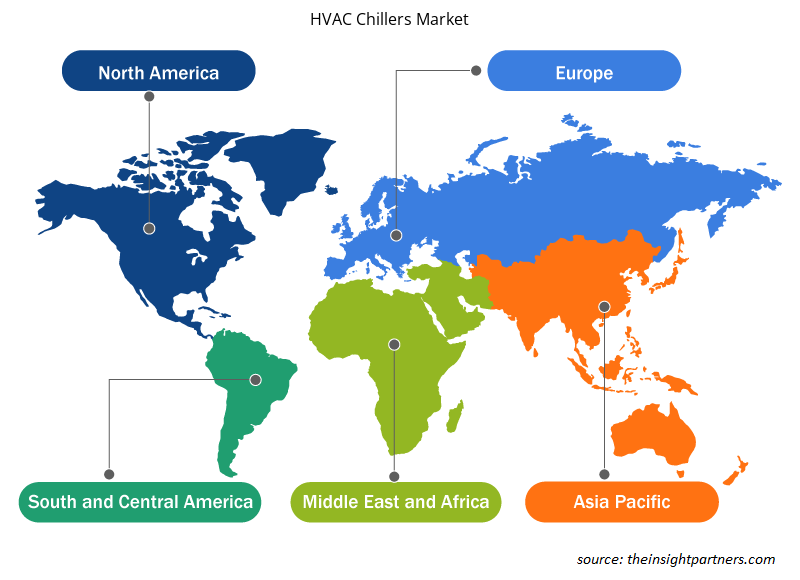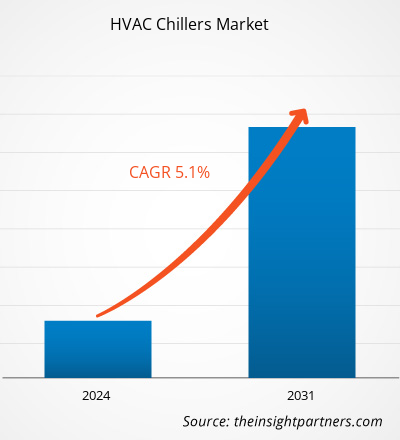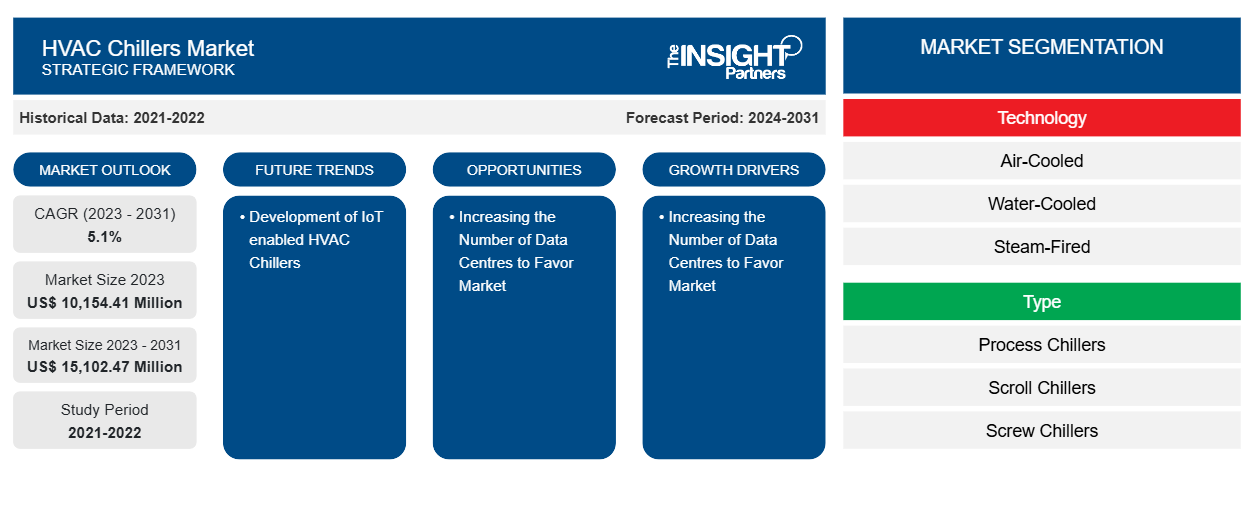Se proyecta que el tamaño del mercado de enfriadores HVAC alcance los US$ 15.102,47 millones para 2031 desde los US$ 10.154,41 millones en 2023. Se espera que el mercado registre una CAGR del 5,1% durante 2023-2031. Es probable que las perspectivas económicas dinámicas y prometedoras en los países en desarrollo y los avances tecnológicos en varios países asiáticos sigan siendo una tendencia clave en el mercado.
Análisis del mercado de enfriadores HVAC
El aumento de la demanda de hogares inteligentes, la creciente industrialización y la urbanización están fortaleciendo la demanda de enfriadores HVAC en todo el mundo. Además, el creciente enfoque en la construcción de rascacielos en China y Japón ha aumentado la conciencia sobre los sistemas de refrigeración por agua helada y está ofreciendo nuevas oportunidades para impulsar la demanda de enfriadores HVAC a nivel mundial. Las condiciones climáticas extremas, el aumento de la población, el crecimiento de los proyectos de infraestructura y desarrollo urbano y las crecientes preocupaciones en materia de atención médica son algunos de los factores clave que obligarán a los actores globales a invertir en el negocio de la calefacción, la ventilación y el aire acondicionado. Además, se prevé que el auge de la industria de la construcción, junto con los hoteles y restaurantes, ayude al crecimiento del mercado de enfriadores HVAC .
Descripción general del mercado de enfriadores HVAC
Los principales actores en el ecosistema del mercado global de enfriadores HVAC incluyen proveedores de materias primas, fabricantes de enfriadores HVAC y usuarios finales. El proveedor de materias primas es un actor crucial en el ecosistema del mercado de enfriadores HVAC . Las principales materias primas son silicio, acero inoxidable, híbridos y otros materiales utilizados principalmente para fabricar los enfriadores HVAC . Los principales proveedores de materias primas incluyen ASTM International, National Bearings, Kineco Limited, Morgan Advanced Materials, etc. ASTM International, que es un proveedor de materias primas para rodamientos, ha anunciado siete nuevos proyectos patrocinados de Investigación a Normas (R2S) para ayudar al Centro de Excelencia de Fabricación Aditiva (AM CoE ) de ASTM y su objetivo de acelerar la estandarización de AM y la adopción de la industria. Como resultado, el aumento de las actividades de los proveedores de materias primas está mejorando la producción de enfriadores HVAC , impulsando el crecimiento del mercado.
Personalice este informe según sus necesidades
Obtendrá personalización en cualquier informe, sin cargo, incluidas partes de este informe o análisis a nivel de país, paquete de datos de Excel, así como también grandes ofertas y descuentos para empresas emergentes y universidades.
- Obtenga las principales tendencias clave del mercado de este informe.Esta muestra GRATUITA incluirá análisis de datos, desde tendencias del mercado hasta estimaciones y pronósticos.
Factores impulsores y oportunidades del mercado de enfriadores HVAC
Aumentar el número de centros de datos para favorecer el mercado
El creciente desarrollo urbano y la proliferación de tecnologías avanzadas, junto con un aumento de la población, han dado lugar a una alta demanda y consumo de energía, debido a lo cual hay un aumento de enfriadores HVAC energéticamente eficientes a nivel mundial. Además, hay un aumento en la instalación de enfriadores HVAC a medida que las nuevas tecnologías HVAC utilizan IA para maximizar la productividad. Se prevé que el aumento en el número de centros de datos impulse el crecimiento del mercado de enfriadores en el futuro cercano en todo el mundo. Los centros de datos necesitan mucha energía, y el principal impulsor del trabajo de los ingenieros de diseño de centros de datos es ofrecer sistemas HVAC confiables, energéticamente eficientes y rentables , que están actuando como un importante impulsor del mercado.
Crecimiento económico en los países en desarrollo del mundo
Las perspectivas económicas positivas en países en desarrollo como China y Japón permiten el desarrollo del mercado de enfriadores HVAC . El mercado de enfriadores HVAC está creciendo debido a los proyectos de construcción comercial junto con un número creciente de complejos comerciales y tiendas minoristas. El alto nivel de vida y el aumento del gasto en salud aumentan la demanda de enfriadores HVAC en las naciones desarrolladas. Además, se prevé que la creciente demanda de unidades de enfriadores de pequeña y mediana potencia en el sur de Europa impulse la demanda de productos en la región, lo que también se proyecta que impulse el crecimiento del mercado de enfriadores HVAC a nivel mundial en los próximos años.
Análisis de segmentación del informe de mercado de enfriadores HVAC
Los segmentos clave que contribuyeron a la derivación del análisis del mercado de enfriadores HVAC son la tecnología, el tipo y la aplicación.
- Según la tecnología, el mercado de enfriadores HVAC se divide en enfriadores por aire, enfriados por agua y alimentados por vapor. El segmento enfriado por aire tuvo una mayor participación de mercado en 2023.
- Según el tipo, el mercado de enfriadores HVAC se divide en enfriadores de proceso, enfriadores de espiral, enfriadores de tornillo , enfriadores centrífugos y enfriadores de absorción. El segmento de enfriadores de tornillo tuvo una mayor participación de mercado en 2023.
- Según la aplicación, el mercado de enfriadores HVAC se divide en comercial, industrial y residencial. El segmento industrial tuvo una mayor participación de mercado en 2023.
Análisis de la cuota de mercado de enfriadores HVAC por geografía
El alcance geográfico del informe de mercado de enfriadores HVAC se divide principalmente en cinco regiones: América del Norte, Asia Pacífico, Europa, Medio Oriente y África, y América del Sur y Central.
La región de Asia Pacífico está liderando el mercado. Las iniciativas gubernamentales en la región de Asia Pacífico, como las iniciativas "Make in India" y "Make in China" para mejorar el sector manufacturero del país, también beneficiarían a la industria de enfriadores HVAC. El creciente desarrollo en los sectores manufacturero, minero y aeroespacial está impulsando la demanda del mercado de enfriadores HVAC en la región de Asia Pacífico.
Perspectivas regionales del mercado de enfriadores HVAC
Los analistas de Insight Partners explicaron en detalle las tendencias y los factores regionales que influyen en el mercado de enfriadores HVAC durante el período de pronóstico. Esta sección también analiza los segmentos y la geografía del mercado de enfriadores HVAC en América del Norte, Europa, Asia Pacífico, Medio Oriente y África, y América del Sur y Central.

- Obtenga datos regionales específicos para el mercado de enfriadores HVAC
Alcance del informe de mercado de enfriadores HVAC
| Atributo del informe | Detalles |
|---|---|
| Tamaño del mercado en 2023 | US$ 10.154,41 millones |
| Tamaño del mercado en 2031 | US$ 15.102,47 millones |
| CAGR global (2023 - 2031) | 5,1% |
| Datos históricos | 2021-2022 |
| Período de pronóstico | 2024-2031 |
| Segmentos cubiertos | Por tecnología
|
| Regiones y países cubiertos | América del norte
|
| Líderes del mercado y perfiles de empresas clave |
|
Densidad de actores del mercado: comprensión de su impacto en la dinámica empresarial
El mercado de enfriadores HVAC está creciendo rápidamente, impulsado por la creciente demanda de los usuarios finales debido a factores como la evolución de las preferencias de los consumidores, los avances tecnológicos y una mayor conciencia de los beneficios del producto. A medida que aumenta la demanda, las empresas amplían sus ofertas, innovan para satisfacer las necesidades de los consumidores y aprovechan las tendencias emergentes, lo que impulsa aún más el crecimiento del mercado.
La densidad de actores del mercado se refiere a la distribución de las empresas o firmas que operan dentro de un mercado o industria en particular. Indica cuántos competidores (actores del mercado) están presentes en un espacio de mercado determinado en relación con su tamaño o valor total de mercado.
Las principales empresas que operan en el mercado de enfriadores HVAC son:
- Electrónica LG
- Corporación Mitsubishi Electric
- Corporación Global Carrier
- INDUSTRIAS DAIKIN, Ltd.
- Cuidado Térmico, Inc.
- Trane
Descargo de responsabilidad : Las empresas enumeradas anteriormente no están clasificadas en ningún orden particular.

- Obtenga una descripción general de los principales actores clave del mercado de enfriadores HVAC
Noticias y desarrollos recientes del mercado de enfriadores HVAC
El mercado de enfriadores HVAC se evalúa mediante la recopilación de datos cualitativos y cuantitativos posteriores a la investigación primaria y secundaria, que incluye publicaciones corporativas importantes, datos de asociaciones y bases de datos. A continuación, se enumeran algunos de los desarrollos en el mercado de enfriadores HVAC:
- Airedale International Air Conditioning Ltd. anunció el lanzamiento de una nueva planta de producción en Virginia, EE. UU. La nueva planta fabricará soluciones de refrigeración para aprovechar las oportunidades en la creciente industria de los centros de datos. (Fuente: Airedale International Air Conditioning Ltd, comunicado de prensa, noviembre de 2022)
- LG Air Conditioning Technologies USA ha lanzado el enfriador con bomba de calor con inversor Scroll (ISHPC) de LG. (Fuente: LG Air Conditioning Technologies, comunicado de prensa, enero de 2022)
Informe de mercado sobre enfriadores HVAC: cobertura y resultados
El informe “Tamaño y pronóstico del mercado de enfriadores HVAC (2021-2031)” proporciona un análisis detallado del mercado que cubre las siguientes áreas:
- Tamaño del mercado de enfriadores HVAC y pronóstico a nivel global, regional y nacional para todos los segmentos clave del mercado cubiertos bajo el alcance
- Tendencias del mercado de enfriadores HVAC, así como dinámica del mercado, como impulsores, restricciones y oportunidades clave
- Análisis PEST y FODA detallados
- Análisis del mercado de enfriadores HVAC que cubre las tendencias clave del mercado, el marco global y regional, los principales actores, las regulaciones y los desarrollos recientes del mercado
- Análisis del panorama de la industria y de la competencia que abarca la concentración del mercado, el análisis de mapas de calor, los actores destacados y los desarrollos recientes del mercado de enfriadores HVAC
- Perfiles detallados de empresas
- Análisis histórico (2 años), año base, pronóstico (7 años) con CAGR
- Análisis PEST y FODA
- Tamaño del mercado, valor/volumen: global, regional y nacional
- Industria y panorama competitivo
- Conjunto de datos de Excel
Informes recientes
Testimonios
Razón para comprar
- Toma de decisiones informada
- Comprensión de la dinámica del mercado
- Análisis competitivo
- Información sobre clientes
- Pronósticos del mercado
- Mitigación de riesgos
- Planificación estratégica
- Justificación de la inversión
- Identificación de mercados emergentes
- Mejora de las estrategias de marketing
- Impulso de la eficiencia operativa
- Alineación con las tendencias regulatorias























 Obtenga una muestra gratuita para - Mercado de enfriadores HVAC
Obtenga una muestra gratuita para - Mercado de enfriadores HVAC